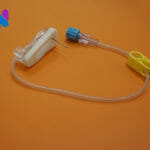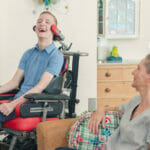Treatment of elderly patients in acute care hospitals is an area of concern. Elderly patients often present with several disorders that lead to significant functional impairment.1 Psychological and social problems are common. Such patients manifest diminished physiologic reserve and a decreased capacity to adapt to unfamiliar surroundings.
The typical hospital ward is a disorienting environment that fosters dependency and exposes patients to considerable risk. It has been found that elderly individuals in acute care have a 36% more likelihood of acquiring a hospital-based infection than their non-elderly counterparts while in an acute setting.2
As a result, several leading models of nursing care in the Geriatric setting have been implemented with varying degrees of success:
- Geriatric Consultation Service Model
- Acute Care for the Elderly (ACE) Model
- Nurses Improving Care for Healthsystem Elders (NICHE) Model
- Geriatric Resource Nurse (GRN) Model
- Hospital Elder Life Program (HELP) Model
In general, these models target the prevention of complications that occur more commonly in older adults and the hospital factors that contribute to complications by employing evidence-based, ageing-sensitive interventions, promoting interdisciplinary communication and emphasizing discharge planning. This is valuable for elder care assistance.
Geriatric Consultation Service Model
Geriatric Consultation Service Models are now commonplace in most developed nations. Their role and function varies considerably:
- Triage services manned by individual geriatricians designed to identify patients suitable for transfer
- Post-acute services, through to well-resourced teams comprising geriatricians, specialist nurses and therapists who actively contribute to care provision in mixed ward settings
It is this latter, more intensive style of service that has been subject to the most intense evaluation. Although early studies showed promise in terms of improved patient outcomes, the majority found no differences when assessed against a range of clinical and administrative outcomes.4,5
Frail older patients represent an increasing proportion of hospital, and the limited success of the Geriatric Consultation Service Model has subsequently resulted in establishing more sustaining models with higher long-term success rates, with nurses required to deliver geriatric specialist expertise to general ward settings. The lessons learnt from the extensive study of geriatric consultation services suggest the need to consider a wider array of potential strategies, as shown below.6
Acute Care for the Elderly Model
Acute Care for the Elderly (ACE) was initially developed by geriatrician researchers to address the adverse events and functional decline that often accompany hospitalization. The ACE unit model generally incorporates:7
- A modified hospital environment
- Early assessment and intensive management to minimize the adverse effects of hospital care
- Early discharge planning
- Patient centered care protocols
- Consistent nursing staff
ACE units in acute care hospitals promote mobility and include processes to provide patient-centered care with nursing-initiated protocols. ACE units involve more intensive discharge planning and more detailed education to improve medication compliance, in comparison with usual hospital care. In clinical trials, care in ACE units was associated with greater independence in ADLs at discharge, less frequent discharge to a nursing home, shorter and less expensive hospitalization and reduced 30-day readmission rates, as well as higher satisfaction rates among patients, family members, clinicians, and nurses.8-10
Nurses Improving Care for Healthsystem Elders (NICHE)
Nurses Improving Care for Healthsystem Elders (NICHE) provides the necessary resources and technical support to assist hospitals systemic capacity to effectively embed evidence-based geriatric knowledge into practice. NICHE is evidence-based program that has been evolving through research conducted over the last 20 years.11
Although all geriatric care models require significant nursing input, only NICHE focuses on the nursing staff’s perception of the care environment for geriatric practice. Studies in NICHE hospitals demonstrate that quality geriatric care requires a positive Nurse Practice Environment (NPE) in which the structure and processes of hospital services focus on specific patient care needs. NICHE has been the most successful in recruiting hospital membership as well as contributing to the depth of geriatric hospital programming.
While all geriatric models of care include a high level of nursing input, only NICHE stresses nurse involvement in hospital decision-making regarding care of older adults. This professional nursing practice perspective supports nurse competencies related to the complex interdisciplinary care management of older adults and the resources they need to improve the safety and outcomes of hospitalized older adults.12
Improved geriatric outcomes at the nurse, patient and organizational levels include both single-site and multisite studies of NICHE hospitals:
- Units that have implemented the GRN model have demonstrated significantly improved nurse knowledge and attitudes related to incontinence
- Improved nurse knowledge related to pressure ulcers, restraint use, incontinence and sleep14
- More positive attitudes about pressure ulcer and restraint management15
- Among clinical process measures relevant to geriatric practice, NICHE units have been associated with reduced physical restraint use16
- Increased compliance with incontinence protocol17
- Improved documentation and family support18
- Decreased incidence of patient complications include new onset of confusion or delirium19
- Facility-acquired incontinence20
- Urinary tract infection rate21
- Pneumonia22
- Mobility loss23
- Pressure ulcers24
- Reported pain25
- Fall-related injuries26
- Reported improved organizational outcomes are decreased length of stay27
- Reduced costs of care28
Geriatric Resource Nurse (GRN) Model
Part of the NICHE model is the utilization of the Geriatric Resource Nurse (GRN) model, as the foundation for NICHE. The underlying goal, improving the geriatric knowledge and expertise of the bedside nurse, is implemented as both an educational and clinical intervention model that prepares staff nurses as the clinical resource person on geriatric issues to other nurses on their unit. G
RNs are trained by geriatric advanced practice nurses to identify and address specific geriatric syndromes such as falls and confusion, as well as implementing care strategies that discourage the use of restrictive devices and promote patient mobility. Over the last decade, the GRN model has remained as the most frequently implemented NICHE model. Thus, the GRN model is often the first step in developing and implementing other systemic geriatric initiatives, such as:
- Geriatric case management
- Transitional care
- Geriatric protocol dissemination
The GRN model has been implemented in many specialty areas, including critical care, oncology, and emergency departments. This requires “fine tuning” clinical knowledge to provide GRNs with focused educational preparation and training, as well as practice tools to provide expert care in these specialty areas. Involvement in specialty organizations provides GRNs the opportunity to shape conference and journal content to reflect the needs of older adult patients.2
Hospital Elder Life Program (HELP)
The Hospital Elder Life Program successfully prevents cognitive and functional decline in at-risk older patients. The program is unique in its hospital-wide focus; in providing skilled staff and volunteers to implement interventions; and in targeting practical interventions toward evidence-based risk factors. In essence, patients aged 70 or greater on specified hospital units are screened on admission for six risk factors:
Cognitive impairment
- Sleep deprivation
- Immobility
- Dehydration
- Vision impairment
- Hearing impairment
Targeted interventions for these risk factors are implemented by an interdisciplinary team, including a geriatric nurse specialist, Elder Life Specialists, trained volunteers, and geriatricians, all who work closely with primary nurses. Other experts provide consultation at twice-weekly interdisciplinary rounds.29
The program also prevents functional decline and falls and allows older adults to return home at the maximal level of independence. HELP does this by keeping hospitalized older people oriented to their surroundings, meeting their needs for nutrition, fluids, and sleep and keeping them mobile within the limitations of their physical condition. Success of the HELP program has been in shown in several areas, including: 30
- Delirium prevention and quality improvement 31
- Prevention of delirium 32
- Prevention of functional decline 33
- Prevention of cognitive decline 34
- Decreased hospital length of stay 35
- Reduced nursing home placement 36
- Decreased rate of hospital falls 37
- Decreased sitter use 38
Conclusions
As with each model of care, it should be noted that geriatric nursing was integrated as part of standard nursing care on selected medical and surgical units, and must be evaluated for both its health outcomes as well as cost-effectiveness for both the hospital as well as the patient. Additionally, barriers to implementation of these models may include:
- Initial difficulties with recruitment and retainment of geriatric resource nurses, due to high nursing turnover and the increased time commitment required
- Breakdown in communication among different departments as well as between clinicians in the same department
- Carryover of recommendations between nursing shifts
- Obstacles to communication between the nursing and medical staff
However, long-term results, especially in regards to general geriatric care with NICHE, and HELP for patients at risk with functional and cognitive decline, have shown that these improvements benefit all involved, and are worth the emotional and initial monetary investment.39
References
1 Warshaw GA, “Functional disability in the hospitalized elderly,” JAMA 1982; 248: 847-850.
2 Steel K, Gertman PM, Cusceuzi C et al: “Iatrogenic illness on a general medical service at a university hospital,” New England Journal of Medicine, 1981; 304: 638-642.
3 SteelFischer GK, Martin LA, Dowal SL, Inouye SK, “Sustaining clinical programs during difficult economic times: a case series from the Hospital Elder Life Program,” Journal of the American Geriatrics Society,2011;59:1873–1882.
4 Hogan DB, Fox RA, Bradley BWD, Mann OE, “Effect of a geriatric consultation service on management of patients in an acute care hospital,” Canadian Medical Association Journal, 1987;136:713-17.
5 Becker PM, McVey LJ, Saltz CC, Feussner JR, Cohen HJ, “Hospital-acquired complications in a randomized controlled clinical trial of a geriatric consultation team,” JAMA, 1987;257:2313-17.
6 Grey, L, “Geriatric consultation: is there a future?” Age and Ageing, Volume 36, Issue 1, Pp. 1-2.
7 Heidi L. Wald, MD, MSPH; Jeffrey J. Glasheen, MD; Jeannette Guerrasio, MD; Jean M. Youngwerth, MD; Ethan Ulysses Cumbler, MD, “Evaluation of a Hospitalist-run Acute Care for the Elderly Service,” Journal of Hospital Medicine, 2011;6(6):313-321.
8 Landefeld CS, Palmer RM, Kresevic DM, et al., “A randomized trial of care in a hospital medical unit especially designed to improve the functional outcomes of acutely ill older patients,” New England Journal of Medicine, 1995; 332:1338.
9 Flood KL, Maclennan PA, McGrew D, et al, “Effects of an acute care for elders unit on costs and 30-day readmissions,”JAMA Intern Med, 2013; 173:981
10 Counsell SR, Holder CM, Liebenauer LL, et al., “Effects of a multicomponent intervention on functional outcomes and process of care in hospitalized older patients: a randomized controlled trial of Acute Care for Elders (ACE) in a community hospital,” Journal of the American Geriatric Society, 2000; 48:1572
11 Boltz M, Capezuti E, Bowar Ferres S, Norman R, Secic M, Kim H, Fairchild S, Fulmer T, Mezey M., “Hospital nurses’ perception of the geriatric nurse practice environment,” Journal of Nursing Scholarship, 2008b;40:282–289
12 Elizabeth Capezuti, Marie Boltz, Daniel Cline, Victoria Vaughn Dickson, Marie-Claire Rosenberg, Laura Wagner, Joseph Shuluk, and Cindy Nigolian, “Nurses Improving Care for Healthsystem Elders – a model for optimising the geriatric nursing practice environment,” Journal of Clinical Nursing, 2012 Nov; 21(21-22): 3117–3125.
13,17 Pfaff J., ”The geriatric resource nurse model: a culture change,” Geriatric Nursing, 2002;23:140–144.
14,15, 18Fitzpatrick JJ, Salinas TK, O’Connor LJ, Stier L, Callahan B, Smith T, White MT, “Nursing care quality initiative for care of hospitalized elders and their families,” Journal of Nursing Quality Care, 2004;19:156–161.
16,21,22,24,26,28 Swauger K, Tomlin C., “Best care for the elderly at Forsyth Medical Center,” Geriatric Nursing, 2002;23:145–150.
19Guthrie P, Edinger G, Schumacher S., “TWICE: a NICHE program at North Memorial Health Care,” Geriatric Nursing, 2002;23:133–138.
20,23,25,27Turner JT, Lee V, Fletcher K, Hudson K, Barton D., “Measuring quality of care with an inpatient elderly population-The Geriatric Resource Nurse Model,” Journal of Gerontological Nursing, 2001;27:8–18.
28 “Models of Care,” NICHE, 2016
29 Inouye SK, Bogardus ST Jr, Baker DI, Leo-Summers L, Cooney LM Jr. “The Hospital Elder Life Program: a model of care to prevent cognitive and functional decline in older hospitalized patients, Hospital Elder Life Program,” Journal of the American Geriatrics Society, 2000 Dec;48(12):1697-706.
30 Hospital Elder Life Program, 2016.
31 Zauber, T., “Quality Improvement and Cost Savings with Multicomponent Delirium Interventions: Replication of the Hospital Elder Life Program in a Community Hospital,” Psychosomatics, May–June, 2013Volume 54, Issue 3, Pages 219–226.
32,35 Rubin, F., “Sustainability and Scalability of the Hospital Elder Life Program at a Community Hospital,” Journal of the American Geriatrics Society, Volume 59, Issue 2, February 2011, Pages 359–365.
33,34 Inouye SK, Bogardus ST Jr, Baker DI, Leo-Summers L, Cooney LM Jr., “The Hospital Elder Life Program: a model of care to prevent cognitive and functional decline in older hospitalized patients. Hospital Elder Life Program,” Journal of the American Geriatrics Society, Volume 48, Issue 12, December 2000, Pages 1697-706.
36-38 Caplan, G.A., “Recruitment of volunteers to improve vitality in the elderly: the REVIVE* study,” Internal Medicine Journal, Volume 37, Issue 2, February 2007, Pages 95–100.
39 Inouye, S., “The Yale Geriatric Care Program: A Model of Care to Prevent Functional Decline in Hospitalized Elderly Patients,” Journal of the American Geriatrics Society, Volume 41, Issue 12, December 1993, Pages 1345–1352.





